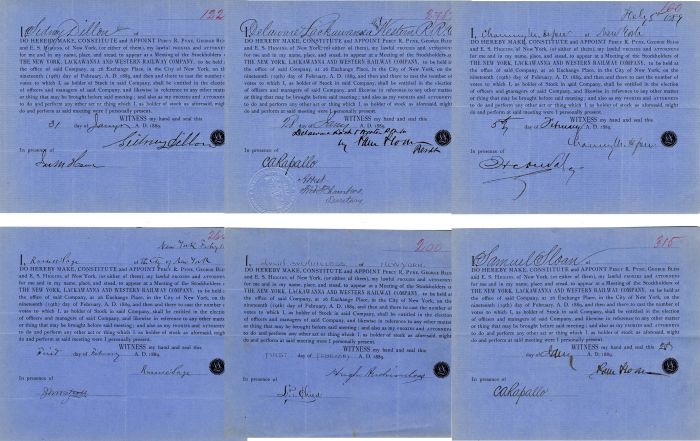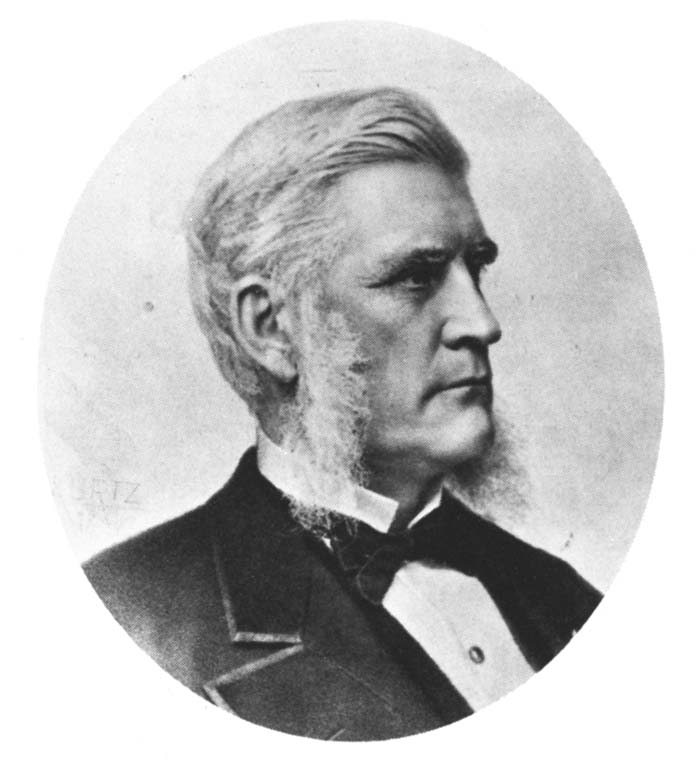6 Documents signed by Sidney Dillon, Russell Sage, Sam Sloan, Chauncey Depew and others
Inv# AU1344
Group of 6 documents appointing lawyers to be representatives at a Meeting of the Stockholders of the New York, Lackawanna and Western Railway Company. Nice! Rare!

Chauncey Depew (1834-1928) A United States Senator from 1899 to 1911. He was a member of Skull & Bones and graduated from Yale College in 1856. He became general counsel for the New York Central Railroad, 1875-83; vice president, 1883-85; and president, 1885-89. He resigned as president in 1898, and became chairman of the board of directors for the entire Vanderbilt railroad system; which included the New York, Harlem, Hudson Valley, Central, Erie, Michigan Southern, Michigan Central, Lakeshore, and Canadian Southern Railroads. He began his political career by serving as a New York state assemblyman in 1862-63. He then was elected Secretary of State for New York, holding that office from 1864-65. Until his was election to the U.S. Senate, 1899. Depew remained prominent in New York politics, in his later years, serving as an advisor and mentor to a younger US President Theodore Roosevelt. In 1871 Depew married Elise Ann Hegeman, and they had one son, Chauncey Mitchell Depew Jr.; who was born in 1879. Elise died in 1893 and Depew married a second time to May Palmer in 1901. They had no children. He was the paternal uncle of Ganson and Chancey Depew, sons of his brother William Beverly Depew. Ganson Depew was a vice president of the Buffalo & Susquehanna Coal Company; and the personnal assistant of his father-in-law Frank Henry "F.H." Goodyear. Goodyear was the president of the Buffalo & Susquehanna Railway. Chancey DePew also worked for the Vanderbilt Railway Systems. When Chauncey Depew died, he was buried in Peekskill. In his honor, the huge concourse of Grand Central Terminal was draped in mourning.

Sidney Dillon (May 7, 1812 – June 9, 1892) was an American railroad executive and one the nation's premier railroad builders.
Dillon was born in Northampton, Fulton County, New York. His father, Timothy, was a farmer.
Sidney Dillon began his career in the industry working as a water boy on the Mohawk and Hudson Railroad, one of America's earliest railroads, for its construction from Albany to Schenectady, New York.
In 1840, he went into business for himself, forming his own construction company, and obtaining the construction contract for the Boston and Albany Railroad.
He was actively involved in the construction of numerous roads, his largest being the Union Pacific Railroad, with which he became actively involved in 1865 through an equity exchange with the Crédit Mobilier of America corporation.
Crédit Mobilier of America was a company set up by the Union Pacific to defraud United States taxpayers in the construction of the First Transcontinental Railroad. The result was the Crédit Mobilier of America scandal, which exposed an over-invoicing and a stock and bond share-pricing scheme, whereby Union Pacific officers and directors, including Dillon, profited by manipulating the share price of Crédit Mobilier of America's stock shares and bonds, padding invoices to the U.S. Government, and bribing congressmen with shares in Crédit Mobilier of America, cash and other perks.
As one of the principal contractors for the Union Pacific, Dillon's vast experience in the construction of railroads proved invaluable. He took part in the "golden spike" ceremony of the First Transcontinental Railroad in 1869, receiving one of the ceremonial silver spikes used to complete the project. Following 1870, Dillon was primarily known as a financier, becoming involved with Jay Gould in numerous ventures as well as serving on the board of directors of the Western Union Telegraph Company. He finally served as President of the Union Pacific Railroad from 1874 to 1884, and again from 1890 until his death in 1892.
In 1841, Dillon married Hannah Smith (1822–1884) of Amherst, Massachusetts. The couple had two daughters:.
- Cora A. Dillon, who married Dr. Peter B. Wyckoff in 1875.
- Julia E. ("Julie") Dillon, who married Josiah Dwight Ripley on May 28, 1862. After his death, she married Gilman Smith Moulton on March 1, 1894.
Dillon died at his home at 23 West Fifty-Seventh Street in New York City, after a twelve-week illness, at the age of 80. Funeral services were held at the Fifth Avenue Presbyterian Church (55th Street and 5th Avenue) on June 13. He is interred under a distinctive Celtic cross at Woodlawn Cemetery in Bronx, New York.
Through his daughter Julia, he was the grandfather of Sidney Dillon Ripley I (1863–1905) and Louis Arthur Dillon Ripley (1878–1958), himself the father of Dillon's great-grandson Sidney Dillon Ripley II (1913–2001), a noted ornithologist, conservationist and Secretary of the Smithsonian Institution for twenty years.
- Dillon, Montana is named for him as it was an early terminus for the railroad.
- Sidney, Nebraska is also named for him.

Russell Sage (1816-1906) Banker; Financier; U.S. Congressman. As the originator of "put and call options", Sage greatly changed the way speculators played the stock market. Among America's most powerful and wealthy bankers, he financed Jay Gould and made a vast fortune on the latter's stock manipulations. "Sage was one of the shrewdest and most conservative of all great financiers." At one time he is said to have had $27,000,000 out on call loans. At the time of his death he left a fortune worth an estimated $70,000,000. Sage was born in the Mohawk Valley and came to Troy to work in his brother’s dry goods store. He became an important figure in Troy, elected to several offices. But he soon expanded beyond Troy. His first wife, Maria, was an Emma Willard graduate but died early and childless. He sought another wife who might be another Emma graduate and whose family would give him proper credentials. His second wife was Margaret Olivia Slocum, who fit all his requirements. They moved to New York City, to a mansion on 5th Avenue, and Russell became allied with Jay Gould. Together they were part of a group which the history books call "robber barons". The Sage-Gould duo bought railroads all over America, including the famous elevated railroad in NYC. They became big investors in the stock market, where it is said Sage invented "puts" and "calls". Sage died in the early 1900’s as perhaps the "19th wealthiest American ever", according to a Fortune publication of the "100 richest" people ever in the American millennium craze pre-2000. Sage died childless, leaving his widow, Margaret Olivia Slocum Sage, the wealthiest woman in America. She chose to be buried in Syracuse with her parents, but was noted as a major philanthropist nation-wide. It has been said that she endowed causes and institutions which her husband would have opposed, such as higher education in general and education for females. A major national cartoon from the early 1900’s shows "Uncle Sam" behind a bank teller’s window, collecting the first national income tax payments. First in line is Russell Sage, a well-known miser, having a hard time getting his payment out of his pocket. Behind him is Hetty Green, another famous miser, known as "the Witch of Wall Street". Last in line is Jay Gould, Russell Sage’s colleague. All are very unhappy to be paying the U. S. any money. Sage’s wife, Margaret, buried him in a Greco-Roman mausoleum by himself, without his name on it, and with a Medusa’s head, snakes and all, carved on a small marble bench next to the mausoleum.

Samuel Sloan (December 25, 1817 – September 22, 1907) was an American politician, businessman and executive. He is most known for his tenure as the president of the Delaware, Lackawanna & Western Railroad (DL&W) for 32 years.
Samuel Sloan was born in Lisburn, County Down, Ireland to William and Elizabeth Sloan and moved to New York when he was one year old. He attended the Columbia College Preparatory school until he was 14, at the time of his father's death. After withdrawing, he became employed at an importing house in New York, eventually becoming the head of the firm.
Sloan was elected as a Supervisor in Kings County (Brooklyn) in 1852, and was president of the Long Island College Hospital. He became a director of the Hudson River Railroad in 1855, left the importing business in 1857 and was elected to the New York State Senate, where he served for two years.
He became a director of the Delaware, Lackawanna & Western Railroad in 1864, and became its president in 1867. Prior to accepting the DL&W Presidency, Sloan had declined an offer to become President of the New York and Harlem Railroad. He extended the DL&W rail lines, and the company achieved great success, in part due to the traffic generated for transport of anthracite coal mined in the railway's expanded territory. Passenger traffic also increased, particularly between New York City and the Pocono Mountains in Pennsylvania, a popular resort area.
Sloan resigned from the DL&W presidency in 1899, but continued as Chairman of the Board. He served on the boards of banks, utilities and other companies.
On April 8, 1844, Sloan married Margaret Elmendorf in New Brunswick, New Jersey, and moved to Brooklyn, New York. Margaret was a daughter of Peter Zabriskie Elmendorf and Maria La Grange (née Van Vechten) Elmendorf. They had eleven children, including:
- Peter Elmendorf Sloan (1845–1916), who graduated from West Point in 1865.
- Maria LaGrange Sloan (1847–1929), who married Edgar Stirling Auchincloss (1847–1892), parents of U.S. Representative James C. Auchincloss.
- Margaret Elmendorf Sloan (1854–1906), who married the Rev. Joseph Rankin Duryee (1853–1935) in 1883.
- William Simpson Sloan (1859–1896), who married Julia Rapallo (1862–1935).
- Elizabeth LaGrange Sloan (1862–1960), who married Joseph Walker Jr. (1858–1927), senior partner and president of the investment banking firm of Joseph Walker & Sons, in 1887.
- Samuel Sloan Jr. (1864–1939), a banker with Farmers' Loan and Trust Company who married Katherine Colt and inherited Oulagisket.
- Mary Adelaide Sloan (1868–1954), who married Richard Collins Colt (1863–1938), parents of banker S. Sloan Colt.
Sloan died in Garrison, New York, in 1907 at the age of 89, having been the president of seventeen corporations during his lifetime.
Samuel Sloan is the eponym of the city of Sloan, Iowa and the village of Sloan, New York.
Upon his daughter Margaret's 1883 marriage, he built "Wyndune" in Garrison as a wedding present for them near his own Garrison estate known as Oulagisket (later renamed Lisburne Grange by his son). Similarly, upon his daughter Elizabeth's 1887 marriage, he built "Walker House" in Garrison for them.
A statue memorializing Sloan was placed in Hoboken, New Jersey, originally facing the ferries in 1899. Some people criticized the statue's orientation, and the Mayor of Hoboken remarked that Sloan was "turning his back on the great city of Hoboken." On August 3, 1908, during the reconstruction of Hoboken Terminal, the statue was set facing both the town and the railroad and ferry stations.









Ebay ID: labarre_galleries